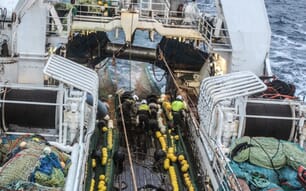The silage system, by PG Flow Solutions, aims to produce high quality fish protein concentrate (FPC) that generates a market value of NOK 12-15 (£1.07 - £1.34) per kilogram, compared to today’s silage value of NOK 2 (£0.18) per kilogram.
The liquid handling and pump specialist’s silage solution integrates treatment and storage tanks into the hulls of long-distance whitefish vessels, to avoid taking up valuable fillet storage space.
The solution – called PG Silage – is designed for long-distance fishing vessels, typically 70-100 metres long, that have quotas that allow them to operate relatively far from home port for weeks at a time.
Today, approximately 30 percent of a white fish is used for human consumption, the rest is primarily utilised for animal feed purposes. While vessels that operate close to port are able to gain an acceptable price for their white fish waste, trawlers that operate far from home port typically sell silage as a low quality product at a relatively low price.
“It is about exploiting the full potential of white fish. Our aim is to increase the price fishing vessels can obtain for their silage from today’s NOK 2 per kilogram to NOK 12-15 per kilogram. More importantly, our solution does this without taking up valuable cargo space,” says Roy Norum, CEO of PG Flow Solutions.
Approximately 2,700 tonnes of fish are required to generate 1,000 tonnes of fish fillet. The remaining 1,700 tonnes are fish waste and equivalent to approximately 1,700m3 with a density of 1kg/l. The PG Silage method manages to reduce this to approximately 310m3 of fish oil and 530m3 concentrated FPC. The concentrated product can be stored up to two months, so that a high quality FPC product can be supplied to a feed producer at a typical price of NOK 12-15 per kilogram.
PG Silage aims to handle almost all types of white fish as it can easily adapt to critical temperature levels of different fish proteins and oils, through remote monitoring of tanks, piping and pumps from the bridge or control tower.
The PG Silage process gathers fresh raw material in a tank directly under the onboard fillet machine. After milling, the autolysis process takes place in this tank. The majority of the fish bone is separated here. The silage is then transported to another tank, which is heated up to its maximum tolerance level in order to separate the fish oil and move it into a separate storage tank. The silage is then moved to a new tank, where remaining liquids are extracted through evaporation. When sufficiently evaporated, the silage is moved to storage tanks that allows it to be sold as fresh, high quality FPC.
“Based on a calculation where a 1,000 tonne freezer trawler conducts five trips annually, including all associated operational costs, we estimate that the repayment period for the entire PG Silage system, excluding depreciation, interests and tax deductions, can be less than two years,” adds Roy Norum.
While discharging fish waste is coming under increased scrutiny in fish quota regulations (EU has already implemented regulations against doing it), transporting untreated waste takes up valuable cargo space onboard the vessel. The industry has attempted to solve this dilemma with on board fishmeal factories. However, high costs and energy requirements have so far resulted in slow adoption levels for this technology, which also requires significant space on board.
“The PG Silage system is significantly cheaper than an onboard fishmeal factory. Additionally, we use recycled heat from the main engine to manage the silage system’s heating process. In sum, our system enables fishing vessels to increase their financial income significantly and ensure that they operate in full compliance with the EU regulatory framework for fish waste,” adds Norum.
PG Flow Solutions will define all specific requirements for volumes, pumps and tank designs that a ship designer requires to accept as a guarantee for the silage process.




